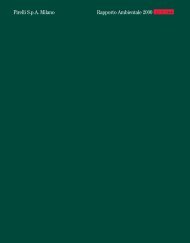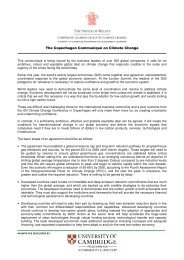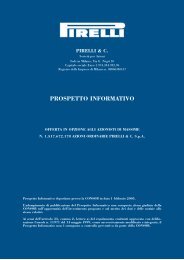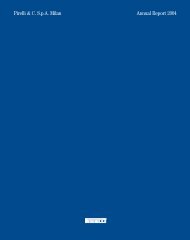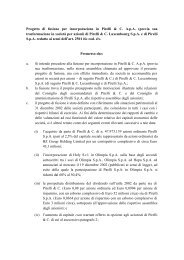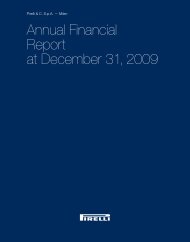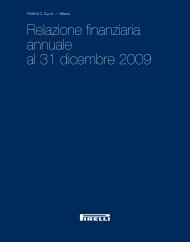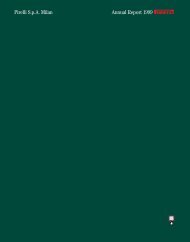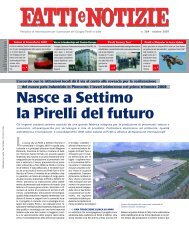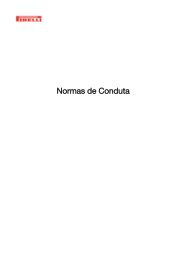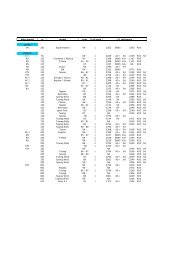14MB - Pirelli
14MB - Pirelli
14MB - Pirelli
Create successful ePaper yourself
Turn your PDF publications into a flip-book with our unique Google optimized e-Paper software.
12.3. Organisational model ex Legislative Decree 231/2001<br />
The internal control system described above has been further strengthened by the introduction<br />
of an organizational model that the Board of Directors approved on 31 July 2003 and which<br />
has been revised and modified according to updated regulations (most recently with a resolution<br />
of the Board of Directors on 9 March 2008). This organisational model, which is intended<br />
to ensure the development of a system that meets the specific requirements deriving from the<br />
entry into force of Legislative Decree 231/2001, on the administrative liability of companies for<br />
criminal offences committed by their employees, the model consists of a set of principles and<br />
procedures arranged in a pyramid that, starting from the base, can be summarized as follows:<br />
—— a Group Code of Ethics, which enunciates the general principles (transparency, correctness<br />
and fairness) that inspire the conduct of business. It indicates the objectives and the values<br />
informing business activity in relation to the main stakeholders with which <strong>Pirelli</strong> & C.<br />
interacts on a daily basis: the shareholders, the financial market, customers, staff and the<br />
community;<br />
—— general principles of internal control, which qualify the Internal Control System, the field<br />
of application of which extends uniformly across the various levels of the organisation;<br />
—— lines of conduct which set out specific rules aiming to avoid the creation of environmental<br />
situations that favour criminal activity in general and, in particular, crimes pursuant to<br />
legislative decree 231/2001, and translate the principles expressed in the Code of Ethics into<br />
operational practice;<br />
—— internal control checklists, which set out the main phases of each high and medium risk<br />
process and, for instrumental processes, the specific checks to be made to reasonably prevent<br />
the risk of any criminal offence and the flows of information to the Supervisory Body<br />
to draw attention to situations of possible non-compliance with the procedures established<br />
in the organisational model.<br />
The Organisational Model mentioned is available on the Company website www.pirelli.com.<br />
A specific Self-Regulatory Body, with full economic independence, monitors the functioning of<br />
and the adherence to the organisational model. It is composed of Carlo Secchi, the Lead Independent<br />
Director and Chairman of the Committee for Internal Control and Corporate Governance,<br />
Statutory Auditor Paolo Domenico Sfameni, a member of the Board of Statutory Auditors,<br />
and Maurizio Bonzi, head of the Internal Audit Department and internal control officer.<br />
This assures the full autonomy and independence of this Body, and the input of the different<br />
professional skills that contribute to the corporate management control.<br />
The Supervisory Body is also charged with making ad hoc recommendations to the Board of Directors<br />
to adapt the organizational model to changes in the legal framework, and to changes in the nature of<br />
the business activities of the Company and the ways in which they are conducted. While the Supervisory<br />
Body reports to the Board of Directors, the Committee for Internal Control and Corporate Governance<br />
and the Board of Statutory Auditors on the checks it has performed and their outcomes.<br />
Each member of the Self-Regulatory Body is paid a gross annual fee of 15,000 euros.<br />
The mandate of the Self-Regulatory appointed by the Board of Directors on 29 April 2008 expires<br />
with that of the Board that appointed it.<br />
With reference to the other Italian companies in the Group, the Self-Regulatory Body has been identified<br />
by seeking the technical and operational solution that, while respecting the mandate and the powers<br />
reserved to this body by law, is appropriate to the size and organizational context of each company.<br />
Lastly, a disciplinary system has been introduced to sanction non-compliance with the measures<br />
indicated in the organisational, operational and control systems.<br />
Finally, it should be pointed out that the Internal Audit Department of <strong>Pirelli</strong> & C. provides,<br />
when requested by the self-regulatory bodies of Group companies, operative assistance in the<br />
management and analysis of information flows established pursuant to Art. 6, subsection 2, letter<br />
d), of Legislative Decree 231/2001, as well as in implementation of specific audits on the basis of<br />
data received through the aforementioned information flows.<br />
During the year, the Self-Regulatory Body became involved in the court case that implicated two<br />
ex-heads of the Security Department of the Company, as detailed in the section entitled “Committee<br />
for Internal Control and Corporate Governance”. In this respect, the Self-Regulatory Body<br />
has taken note of the circumstances reported in the aforementioned section.<br />
ANNUAL FINANCIAL REPORT 2008<br />
109



